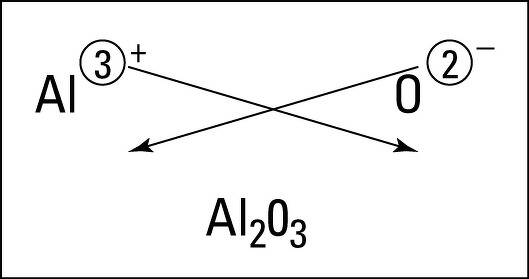
The formula of Aluminium oxide is
Answer
525.3k+ views
1 likes
- Hint: We know that the atomic number of Aluminium is 13 and the atomic number of Oxygen is 8. Using the criss-cross method we can determine the valency of Aluminium and Oxygen in Aluminium oxide or
Complete step by step answer:
We know that according to Bohr’s atomic model, the number of electrons that can be present on the different shells is determined by the formula
Since the atomic number of Aluminium is 13, using the formula
In the first shell, the number of electrons is
In the second shell, the number of electrons is
In the third shell, the number of valence electrons is = 3 electrons.
Since
Now, the atomic number of Oxygen is 8. Using the formula
In the first shell, the number of electrons is
In the second shell, the number of valence electrons = 6 electrons.
Since
Therefore, to attain the octet configuration, Aluminium loses 3 electrons, and Oxygen gains 2 electrons.
Now, we have to write the formula of Aluminium Oxide using the criss-cross method.
We know that in the criss-cross method the numerical value of each of the ion charges is crossed over to become the subscript of the other ion.
The charge of Aluminium is +3 and the charge of Oxygen is -2.

Therefore, we can conclude that the valency of Aluminium in
Note: Aluminium loses the 3 valence electrons to gain the noble gas configuration of Neon, which is 2,8.
Similarly, Oxygen gains 2 valence electrons to gain the noble gas configuration of Neon, that is 2,8.
Complete step by step answer:
We know that according to Bohr’s atomic model, the number of electrons that can be present on the different shells is determined by the formula
Since the atomic number of Aluminium is 13, using the formula
In the first shell, the number of electrons is
In the second shell, the number of electrons is
In the third shell, the number of valence electrons is = 3 electrons.
Since
Now, the atomic number of Oxygen is 8. Using the formula
In the first shell, the number of electrons is
In the second shell, the number of valence electrons = 6 electrons.
Since
Therefore, to attain the octet configuration, Aluminium loses 3 electrons, and Oxygen gains 2 electrons.
Now, we have to write the formula of Aluminium Oxide using the criss-cross method.
We know that in the criss-cross method the numerical value of each of the ion charges is crossed over to become the subscript of the other ion.
The charge of Aluminium is +3 and the charge of Oxygen is -2.

Therefore, we can conclude that the valency of Aluminium in
Note: Aluminium loses the 3 valence electrons to gain the noble gas configuration of Neon, which is 2,8.
Similarly, Oxygen gains 2 valence electrons to gain the noble gas configuration of Neon, that is 2,8.
Latest Vedantu courses for you
Grade 10 | MAHARASHTRABOARD | SCHOOL | English
Vedantu 10 Maharashtra Pro Lite (2025-26)
School Full course for MAHARASHTRABOARD students
₹33,300 per year
Recently Updated Pages
Master Class 11 Business Studies: Engaging Questions & Answers for Success

Master Class 11 Accountancy: Engaging Questions & Answers for Success

Master Class 11 Computer Science: Engaging Questions & Answers for Success

Master Class 11 English: Engaging Questions & Answers for Success

Master Class 11 Social Science: Engaging Questions & Answers for Success

Master Class 11 Economics: Engaging Questions & Answers for Success

Trending doubts
Which one is a true fish A Jellyfish B Starfish C Dogfish class 11 biology CBSE

State and prove Bernoullis theorem class 11 physics CBSE

1 ton equals to A 100 kg B 1000 kg C 10 kg D 10000 class 11 physics CBSE

In which part of the body the blood is purified oxygenation class 11 biology CBSE

One Metric ton is equal to kg A 10000 B 1000 C 100 class 11 physics CBSE

Difference Between Prokaryotic Cells and Eukaryotic Cells




